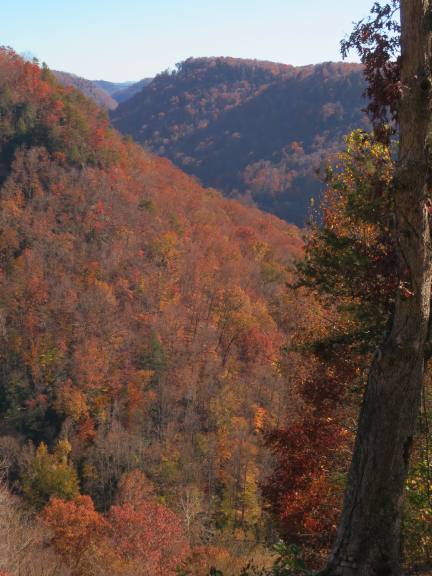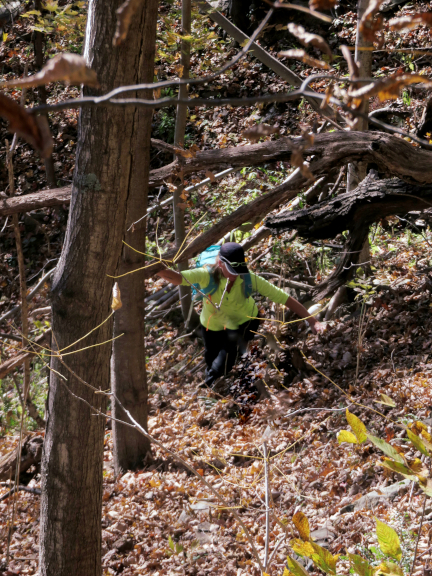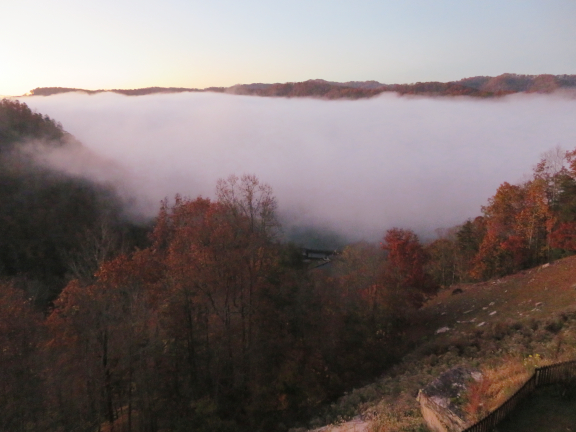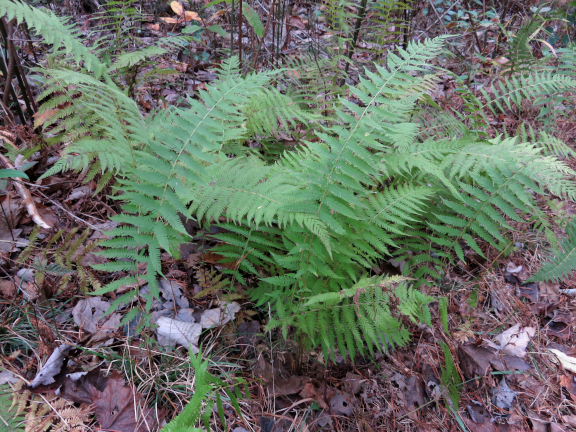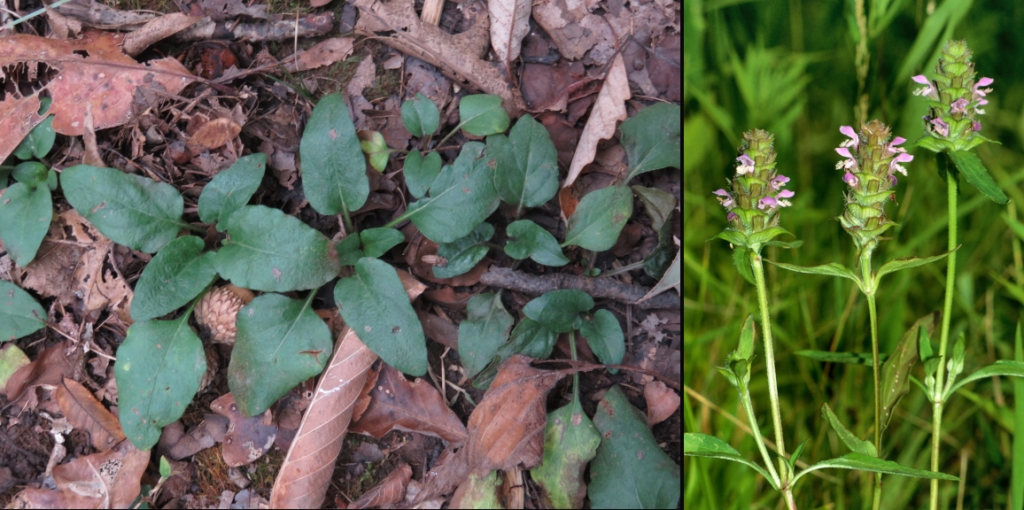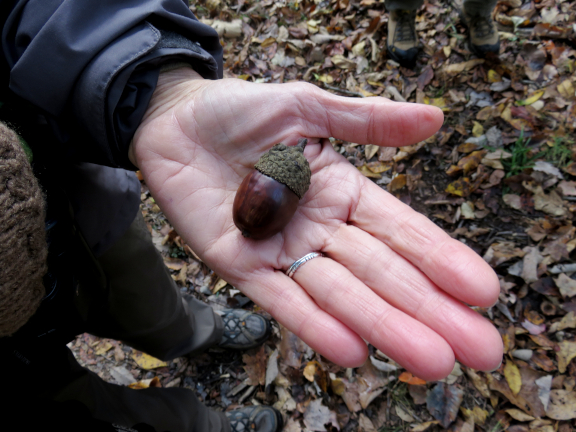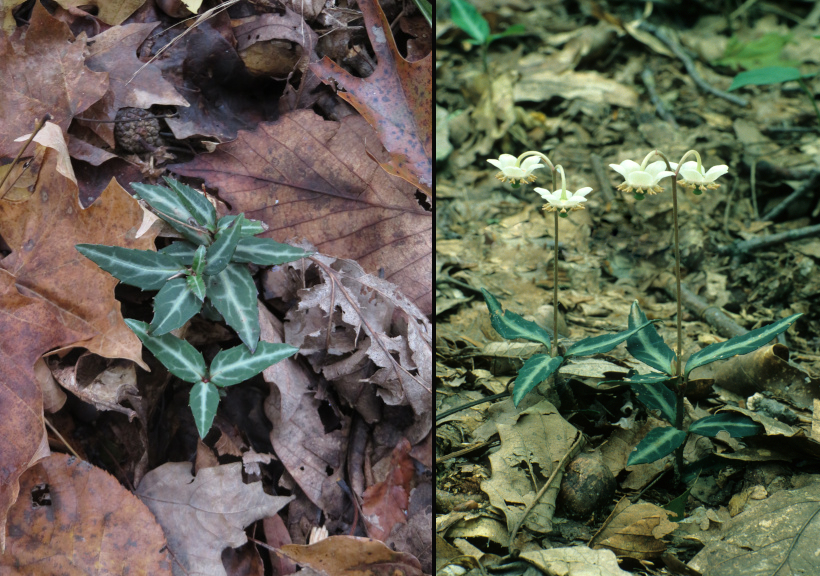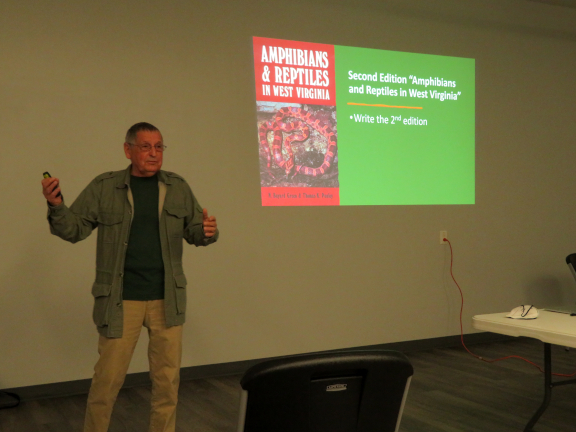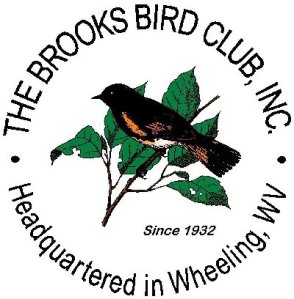Members of the Brooks Bird Club from all over the state and beyond gathered at Hawk’s Nest State Park for the club’s fall board meeting and to celebrate the club’s 90th anniversary. For Jan and me the weekend began with a social get together with some old and new friends.
Perched on the top edge of the steep New River Gorge, the lodge at Hawk’s Nest State Park is built so that every room has a view toward the scenic valley of the New River.
The river begins in North Carolina and cuts across much of the Appalachian Mountains, traveling 360 miles through Virginia and West Virginia on its way to join the Gauley River to form the Kanawha River. As part of the Ohio River watershed, it has been eroding through the Appalachians for between 10 and 360 million years (depending on the geological assumptions used to date it). This erosion has cut a low-level crossing into the mountains, creating a biogeographical corridor which has allowed many species of plants and animals to spread from the east coast of the U.S. into midwest areas. Later humans have used this low level crossing to help more easily transport raw materials and goods into and out of the mountainous areas and beyond (see the field trip below to a former coal-mining town along the river). The railroad line along the river, seen below from our room, is still in use.
After supper we were entertained by storyteller, actress, and writer Karen Vuranch. She portrayed Mary Draper Ingles (1732 – February 1815), an early settler of western Virginia (near present-day Blacksburg, VA). In the summer of 1755, Mary and her two young sons were among several captives taken by Shawnee Native Americans after the Draper’s Meadow Massacre. Ingles escaped with another woman after two and a half months in captivity and trekked 500-600 miles in the winter, crossing numerous rivers, creeks, and many Appalachian Mountains to return home. Karen’s portrayal, based on her vast research, was interesting and compelling.
On Saturday morning the group photo was taken.
After the photo, all but one of the group gathered for a field trip to scenic and historical areas in the New River Gorge National Park and Preserve. The trip was led by Jodi French-Burr, Interpretive Park Ranger in the New River Gorge. Not only did Jodi lead the BBC group on a great field trip, she also presented a Nature/History program about the New River Gorge area on Saturday evening.
First Jodi took the group to the remains of the coal-mining town of Nuttallburg which was typical of dozens of towns that grew up along the New River in the late 1800s and early 1900s.
The town is near the bottom of the steep New River gorge, not too far above the river.
The coal seam is about half-way up the steep gorge. In the early 1900s, to get coal down to the C&O railroad line at the bottom of the valley more easily, a long conveyor was built which brought the coal to the tipple where the coal was sorted before being loaded. Railroad coal cars were brought under the tipple and filled with the valuable “smokeless” coal being mined up the hill. There was even a smaller loading area where wagons could be loaded with coal.
While the conveyor and tipple have been restored, all that remains of the dozens of “company” houses where the coal miners and their families lived are the stone foundations which are slowly being covered and reclaimed by Nature.
Then Jodi took the group to Babcock State Park to tour the Glade Creek Grist Mill which is a fully functional replica of the mill that used to be nearby. The current mill was created using parts from three other old, dismantled West Virginia mills. The miller explained a lot about the current mill and how it works. Everything in the mill was made of wood since a spark from metal parts could ignite an explosion of the highly flammable chaff and flour dust. Unfortunately, the shop had sold out of the different kinds of grain they grind there, so the only things brought home were photos.
Customers usually paid the miller who was grinding their grain with a portion of the finished flour/meal. The two flat “paddles” below were used to figure that amount. A paddle would be dipped into the finished flour/meal and whatever stayed on the paddle was kept by the miller as his payment for grinding the grain.
The Glade Creek Grist Mill is one of many very picturesque places in West Virginia.
The group had lunch at a very scenic lookout in Babcock State Park. The New River Gorge Bridge was even partly visible in the distance.
But, I wanted to hike, soooo….I was the one who didn’t go with the rest of the group for the scheduled field trip. Instead, my first destination was the Endless Wall Trail.
Early in the trail there were man-made steps and bridges, but soon the trail was all nature.
The Endless Wall Trail is 2.5 miles long with a 0.5 mile walk back to the car along a paved road. It is also a popular destination for rock climbers.
The Endless Wall Trail has numerous short side trails which end at overlooks along the New River. It’s very scenic.
The trail is well named. Even though the trail itself is away from the “endless wall” of high, sheer rock walls, some of the overlooks show the many cliffs.
I often hike alone and enjoy it. That day, through a series of serendipitous encounters, a woman named Kim and I bumped into each other at various spots on the trail and eventually we walked together back to where our cars were parked. We parted ways sure we would never see each other again.
I had agreed to meet the rest of the group back at Hawks Nest after lunch, but they were late. I waited a while, but then just decided to go hiking. I wanted to hike the Cliffside Trail. To my surprise, I ran into Kim again. She also wanted to hike the Cliffside Trail. So off we went. The beginning of the trail is very scenic.
The “Trail to Lodge” sign might have been a foreshadowing we should have listened to.
We met 2 hikers who had been on the Hawks Nest Lake and Fishermans Trails. Their comments inspired us to follow those trails.
Down we went. We continued down, following the zigzagging Hawks Nest Lake Trail to the Fishermans Trail along the New River. To our surprise we encountered others walking the trail and a young man at one of the Tentrr Campsites available through Hawks Nest State Park. We discovered there was a parking area not far away. For more information about the Tentrr Campsites see — https://wvstateparks.com/places-to-stay/unique-stay/tentrr-campsites-at-hawks-nest-state-park/
Near the end of the Fishermans Trail was a small, high waterfall.
At the waterfall, we thought about the hike back to the Hawks Nest Lake Trail, and then the uphill zigzagging we faced, so we decided it was time to turn around and start back. Although I didn’t know much about Kim’s hiking abilities, I suggested, “Instead of hiking zigzag all the way back, why don’t we just bushwhack from here straight up to the trail. It’s not that far and not too steep.” FAMOUS LAST WORDS! As it turned out it was a lot farther than I had thought, and, in places, very steep. Much of our vertical hike/climb used our hands as much as our feet. It was a lot more strenuous than if we had gone back the way we had come.
Kim and I did make it safely back up to the Cliffside Trail and then back to the Hawks Nest Lodge…with a great story to tell.
All too soon it was time to say goodbye to our BBC friends until the next whole-club get-together next spring. Regardless of which adventure each of us did on Saturday, we all had a great time at the Brooks Bird Club’s 90th Anniversary.














